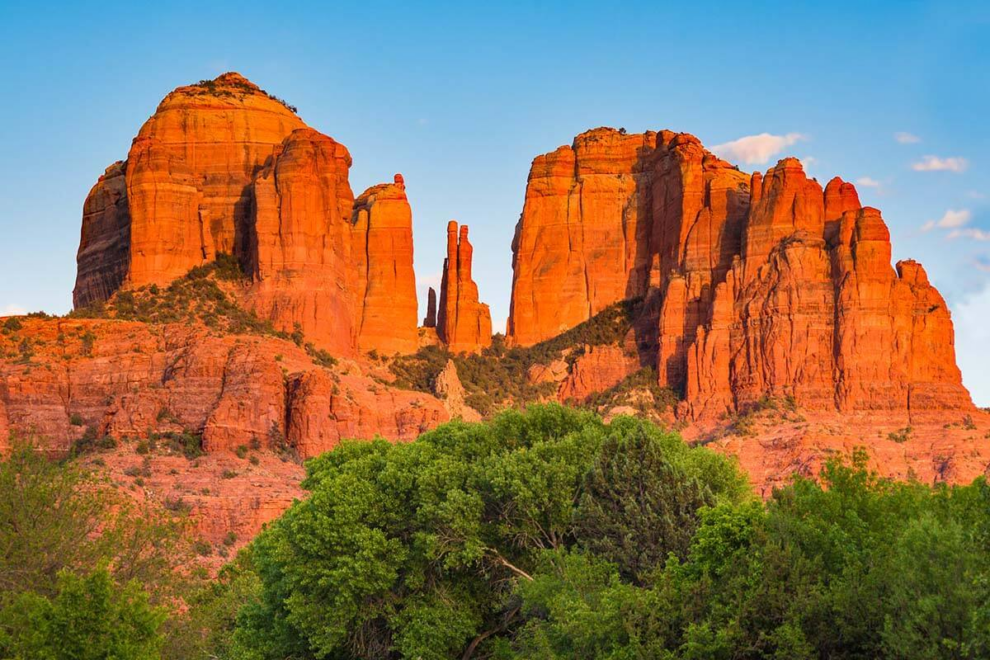Spirituality is anchored deep within ancient cultures, and many civilizations dwelled and left their mark in distinct places around the world so sacred that some are thought to represent the Earth’s seven chakras. The Mount of Olives and the Great Pyramid of Giza, for instance, embody the throat chakra, while Bolivia and Peru’s Lake Titicaca, the largest lake in South America, is considered a mystical repository for the sacral chakra.
Sedona, in the Arizona desert, is another spiritual hotspot; it attracts spiritualists, geologists, and hikers alike, as it is famed for both its rugged beauty and its plethora of sites representing Native American culture, namely the Sinagua. Current active tribes there include the Hopi, Navajo, Tonto Apache, and Yavapai.
Sedona itself as a city offers plenty to do and see. However, for adventurers seeking to explore its more spiritual side and the culturally important sites peppered throughout the area, here are a number of awe-inspiring spiritual monuments and dwellings that are unique to Sedona and sacred to the area’s Native Americans.
10 Tuzigoot National Monument
Tuzigoot National Monument is what is left of a 110-room limestone and sandstone village that was occupied between 1125 and 1400 CE and covered the upper terraces of a 120-foot ridge overlooking the Verde Valley. It was excavated in the 1930s and became a national monument in 1939. Today, it is the largest and best-preserved village ruins in the Verde Valley.
9 Wupatki National Monument
Wupatki National Monument, whose name means “long-cut house,” is one of the many great Native American archeological sites in the US to have on the bucket list. Constructed between 1100 and 1200 CE, it was home to about 150 residents who harvested rainwater and planted maize and squash. The Hopi believe that this sacred place is looked after by spiritual guardians. It was also once the largest free-standing village in Northern Arizona.
8 Honanki Heritage Site
There are many incredible ancient places with petroglyphs in the US (as well as pictographs), and the Honanki Heritage Site in Coconino National Forest, which was occupied from 1150 to 1350 CE, is one of them; it’s a fascinating depiction of early human life, albeit located in a remote canyon. The name means “badger house” in the Hopi language, and some of the pictographs and petroglyphs even date back much earlier to about 5000 BCE.
7 Palatki Heritage Site
Meaning “Red House” in the Hopi language as a reference to the local sandstone, Palatki Heritage Site is Honanki’s Sister Site In Red Rock State Park. The site consists of two neighboring settlements, likely for two kin groups, who planted crops and created pottery. It includes several pictographs and petroglyphs, the most abstract of which are between 5000 and 6000 years old.
6 V-Bar-V Heritage Site
Named for the original ranch at that location, V-Bar-V Heritage Site is located near Beaver Creek Campground in Rimrock and was acquired by the Coconino National Forest in 1994. Petroglyphs include snakes, turtles, coyotes, deer, and sacred spirals. On the summer solstice, a shadow from the left edge points to a petroglyph depicting the planting of summer crops.
5 Montezuma Castle
Constructed out of stone and mortar at 80 feet above the ground, Montezuma Castle is one of the most impressive and well-preserved ancient cliff dwellings of the Southwest. Located in Camp Verde, Montezuma Castle National Monument offers a lot to see; it comprises 20 rooms and was occupied by up to 50 people between 1100 and 1425 CE. This site is very important to 16 Native tribes; it is mentioned in their oral histories and symbolizes their adaption to a harsh environment.
4 Airport Mesa
Along with offering stunning views of some of Arizona’s most iconic rock formations (which also happen to be among the sacred Native American sites in Sedona), including Cathedral Rock, Bell Rock, and Boynton Canyon, Airport Mesa is one of Sedona’s main energy vortexes that attracts many nature lovers, hikers, and spiritualists, especially around dawn and dusk, both thought to be energy-filled time periods.
Not only is this spot one of the most sacred sites in Sedona, but it also makes for one of the world’s one-of-a-kind meditation experiences. Although, it can get very crowded. Visitors can also hike the easy-to-moderate difficulty Sedona Airport Loop Trail here, which is about 3.3 miles and takes around 1.5 hours to complete.
3 Cathedral Rock
Not to be confused with its namesake in Tasmania, this Cathedral Rock is located within the Coconino National Forest and has a summit elevation of 4,967 feet. It is thought to be the site of the First Man and Woman and was exclusively visited by chiefs and healers.
2 The Kachina Woman
The Kachina Woman vortex is another one of the many spiritual sites in Sedona, which represents feminine energy. Standing at 80 feet and sometimes known as the Boynton Spire, this striking rock formation is said to depict a female figure balancing a canoe on her head. Legend says it holds the spirit of a daughter whose loving father built her a raft to help her survive an upcoming flood. She now protects passersby and is honored in Hopi dance ceremonies.
1 Courthouse Butte
With an elevation of 5,454 feet, Courthouse Butte is a stunning red rock formation that stands north of the unincorporated Village of Oak Creek. It is one of Sedona’s most sacred sites and has attracted many visitors in search of spiritual cleansing and balance.
Source: The Travel
















